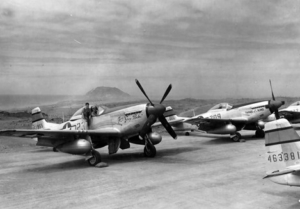Scroll of Honor – Henry Randolph Peebles
Flight from Iwo Jima
Written by: Kelly Durham

46th Fighter Squadron P-51s with Iwo Jima’s Mount Suribachi in the background
The idea was to capture Iwo Jima, one of the Pacific’s Volcano Islands, in order to prevent the Japanese from continuing to use the island’s airfields. Iwo Jima, about seven hundred sixty miles south-southeast of Tokyo, was home to Japanese fighter aircraft that were attacking American B-29 strategic bombers as they flew missions to bomb Japanese cities from recently captured bases in the Marianna Islands. After a bloody campaign in which American casualties were higher than the enemy’s, Iwo Jima finally fell to US Marines in late March 1945. Even before the battle was won, American Army Air Force units began to operate from airfields newly-wrested from Japanese control. The 46th Fighter Squadron was one of these units. At the controls of one of the 46th’s P-51 Mustang fighters was Second Lieutenant Henry Randolph Peebles, Clemson College Class of 1945.
Peebles was born in North Carolina, but his family moved to Clemson and in 1941, he enrolled in his hometown college as a freshman. A mechanical engineering major, Peebles quit school in 1942. He traveled to Miami Beach and enlisted on February 28, volunteering for the Army Air Force. Selected for flight training, Peebles was designated a fighter pilot, earning his wings and being assigned to the 46th Fighter Squadron. The 46th was one of the Army Air Force units surprised by the Japanese attack on Hawaii in December 1941. It was largely destroyed by the strike on Hickam Field, but by the spring of 1945, the reconstituted squadron was on the offensive. It had long since retired its P-39 and P-40 fighters in favor of the long-range P-38 Lightning and the Mustang. Flying these aircraft, the squadron flew long missions over the empty Pacific escorting B-29 Superfortresses on their fire bombing missions against Japanese cities.
On May 10, 1945, rather than escort duty, Peebles was assigned to fly an offensive strafing and dive bombing mission against Japanese facilities on Chichi Jima island, about one hundred fifty miles to the north. At approximately 1000 hours, Peebles, flying in the fourth position of the formation, started his dive bomb run from 10,000 feet above Chichi Jima. His airplane disappeared through an overcast. After about five seconds, the next pilot in the formation, First Lieutenant George Dunstan, pushed his control stick forward and followed Peebles down. Dunstan then saw a big explosion east of the target. He could not discern whether the explosion was from a bomb or was Peebles’s P-51. There was no further contact with Lieutenant Peebles and despite a thorough search of the area, no trace of the aircraft or of Lieutenant Peebles was found.
Peebles was listed as missing in action. He was awarded the Air Medal and the Purple Heart. On May 11, 1946, he was declared dead. He is memorialized at the Honolulu Memorial in Hawaii.
For more information on Henry Randolph Peebles see: https://soh.alumni.clemson.edu/scroll/henry-randolph-peebles/
For additional information about Clemson University’s Scroll of Honor visit: https://soh.alumni.clemson.edu/
